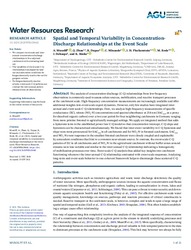Spatial and Temporal Variability in Concentration‐Discharge Relationships at the Event Scale
DOI: https://doi.org/10.1029/2020WR029442
Persistent URL: http://resolver.sub.uni-goettingen.de/purl?gldocs-11858/9829
Persistent URL: http://resolver.sub.uni-goettingen.de/purl?gldocs-11858/9829
Musolff, A.; Zhan, Q.; Dupas, R.; Minaudo, C.; Fleckenstein, J. H.; Rode, M.; Dehaspe, J.; Rinke, K., 2021: Spatial and Temporal Variability in Concentration‐Discharge Relationships at the Event Scale. In: Water Resources Research, Band 57, 10, DOI: 10.1029/2020WR029442.
 |
Dokument öffnen: |
The analysis of concentration‐discharge (C‐Q) relationships from low‐frequency observations is commonly used to assess solute sources, mobilization, and reactive transport processes at the catchment scale. High‐frequency concentration measurements are increasingly available and offer additional insights into event‐scale export dynamics. However, only few studies have integrated inter‐annual and event‐scale C‐Q relationships. Here, we analyze high‐frequency measurements of specific conductance (EC), nitrate (NO3‐N) concentrations and spectral absorbance at 254 nm (SAC254, as a proxy for dissolved organic carbon) over a two year period for four neighboring catchments in Germany ranging from more pristine forested to agriculturally managed settings. We apply an integrated method that adds a hysteresis term to the established power law C‐Q model so that concentration intercept, C‐Q slope and hysteresis can be characterized simultaneously. We found that inter‐event variability in C‐Q hysteresis and slope were most pronounced for SAC254 in all catchments and for NO3‐N in forested catchments. SAC254 and NO3‐N event responses in the smallest forested catchment were closely coupled and explainable by antecedent conditions that hint to a common near‐stream source. In contrast, the event‐scale C‐Q patterns of EC in all catchments and of NO3‐N in the agricultural catchment without buffer zones around streams were less variable and similar to the inter‐annual C‐Q relationship indicating a homogeneity of mobilization processes over time. Event‐scale C‐Q analysis thus added key insights into catchment functioning whenever the inter‐annual C‐Q relationship contrasted with event‐scale responses. Analyzing long‐term and event‐scale behavior in one coherent framework helps to disentangle these scattered C‐Q patterns. Key Points:
We compare event‐scale and inter‐annual concentration‐discharge relationships in four adjoined catchments with contrasting land use.
The variability of event‐scale C‐Q relationships was shaped by land use and antecedent conditions for biogeochemically reactive but not for geogenic solutes.
For biogeochemically reactive solutes, event‐scale C‐Q patterns can contrast the inter‐annual pattern obtained from all observations.
Statistik:
ZugriffsstatistikSammlung:
- Geographie, Hydrologie [454]
Schlagworte:
water qualitynutrients and nutrient cycling
catchment
time series analysis
instruments and techniques: modeling
This is an open access article under the terms of the Creative Commons Attribution‐NonCommercial‐NoDerivs License, which permits use and distribution in any medium, provided the original work is properly cited, the use is non‐commercial and no modifications or adaptations are made.

